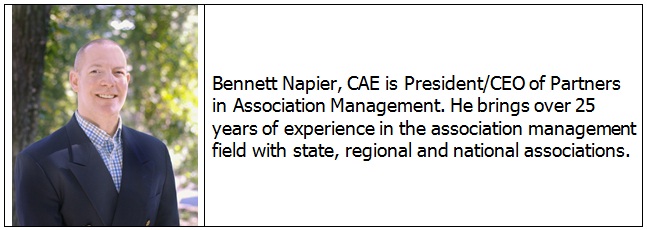By: Bennett Napier, CAE
There are countless articles that have been written about the importance of honesty and transparency in the work environment. The common theme of most of the references is that employer transparency is the cornerstone of building a strong company culture.
The reasons to do it are obvious.
- Employees want the “why” behind a policy, procedure or decision. They may not like the decision but at least they may have a clearer understanding and appreciate the rationale behind a decision.
- The workforce environment has been a rocky road for many businesses since 2008. Lack of information, inconsistent communication or sugar coating the obvious with team members only creates more problems down the road. There is a lot of distrust and insecurity of the
“business world” due to economic conditions. No communication in today’s market leads employees to perceive something bad is about to happen. People want candor even if its bad news. - The ability to share information with the full team and talk through tough issues, operational or strategic creates a dynamic of mutual respect. Achieving a workplace where you can have “positive conflict and debate” results in better morale, better production and a better work product, whether you are making widgets or delivering a professional service.
If the reasons to have a transparent work environment are so beneficial, why do many organizations not do it? Easy answer, it’s hard!
Building a culture of transparency is a process, you don’t flip a switch. Along the way, there will be bumps in the road. You will no doubt encounter emotions (and in some cases not from the people you expected); a flurry of questions once new or more detailed information is put out for public consumption; and there will be tried and true disbelief that moving in this direction is for real (there must some other agenda).
For any leader (a CEO or someone supervising one employee), chances are you, you are already busy, don’t let that get in the way. I cannot tell you how far to go with transparency in your organization, every organization is different, however, my opinion based on experience, having also been an employee before I was a CEO, is that holding critical information close to the cuff will always bite you in the end. Lack of transparency will ultimately affect your organization’s ability to recruit and retain talent and impact the potential of your business regardless of type.
Our firm started down the transparency road in 2008 working with an outside firm called, Catch Your Limit Consulting, www.catchyourlimit.com.
The foundation of the introspective process, involved both managers and the full team at various times using the book and field guide, The Five Dysfunctions of a Team for nearly 2 ½ years. After the first 2 ½ years we managed the culture building process internally and continue to do so.
After a period of time, we wanted to measure change and get a clear view of whether or not we were actually achieving core objectives. We determined that for us it was important to undergo an outside review of what we were doing and our organization chose to participate in the “Best Companies to Work For” program administered by Florida Trend magazine.
The process is two parts, with the employer submitting very detailed information on a number of topics and the second part, is the core, where each team member submits anonymous responses to an online assessment covering nearly eighty five workplace subjects.
Similar programs are available in most states. We did not get “ranked” the 1st year. Collectively, our team voted to do it for several more years and we were honored to “rank” in the small business category for three year’s running, and to as continued to implement incremental changes, our ranking improved each of the three years.
I have no doubt that being more transparent across the board on subjects such as wages and benefits; revenues/expenses and profitability and sharing benchmarking data from other like size businesses has played a large part in our ongoing cultural improvement.
You are never done with this type of initiative. There is no goal line, you just keeping moving the ball forward, but the rewards are clearly worth it.
Photo Credits: Images courtesy of stockimages, imagerymajestic, Stuart Miles, and renjith krishnan and all images provided by FreeDigitalPhotos.net








